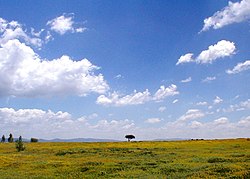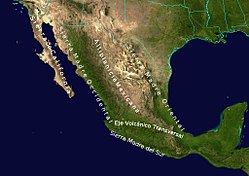This article needs additional citations for verification. (September 2020) |
Mexican Plateau
Altiplanicie Mexicana | |
|---|---|
Region | |
 A view of the Mexican Plateau near San Miguel de Allende, Guanajuato | |
 Geographic map of the highest Mountain Ranges of Mexico. | |
| Coordinates: 24°N 103°W / 24°N 103°W | |
| Country | Mexico |
| Area | |
• Total | 601,882 km2 (232,388 sq mi) |
| Population (2000[1]) | |
• Total | 74,900,000 |
| • Density | 120/km2 (320/sq mi) |
The Central Mexican Plateau, also known as the Mexican Altiplano (Spanish: Altiplano mexicano), is a large arid-to-semiarid plateau that occupies much of northern and central Mexico. Averaging 1,825 m (5,988 ft) above sea level, it extends from the United States border in the north to the Trans-Mexican Volcanic Belt in the south, and is bounded by the Sierra Madre Occidental and Sierra Madre Oriental to the west and east, respectively.
A low east-west mountain range in the state of Zacatecas divides the plateau into northern and southern sections. These two sections, called the Northern Plateau (Mesa del Norte) and Central Plateau (Mesa Central), are now generally regarded by geographers as sections of one plateau.
The Mexican Plateau is mostly covered by deserts and xeric shrublands, with pine-oak forests covering the surrounding mountain ranges and forming sky islands on some of the interior ranges. The Mexican Altiplano is one of six distinct physiographic sections of the Basin and Range Province, which in turn is part of the Intermontane Plateaus physiographic division.
In phytogeography, the Sonoran Desert is within the Sonoran Floristic Province of the Madrean Region in southwestern North America, part of the Holarctic realm of the northern Western Hemisphere.
While the plateau stretches from north to south, the southern east-west arc of the Central Mexican Plateau from Jalisco to Veracruz states historically as well as today has served as the population nexus of the Mexican nation, it is home to its biggest metro areas of Guadalajara, León, Querétaro, Morelia, Mexico City, Toluca, Cuernavaca, and Puebla.